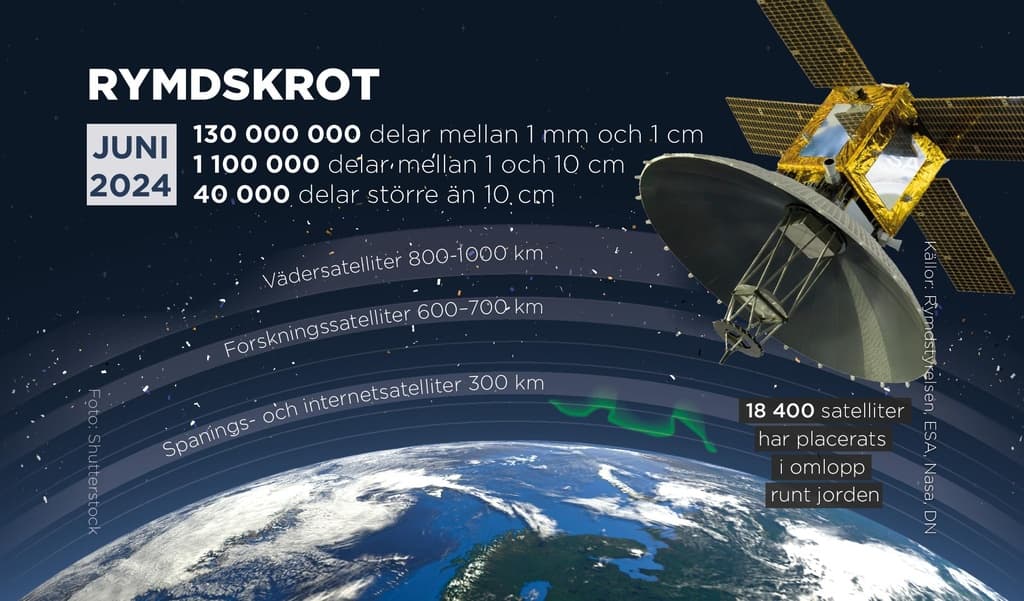Humans litter, even in space. The problem of so-called space debris – old satellites or parts that have broken off from spacecraft – is bigger than one can imagine.
There are approximately 40,000 pieces of space debris larger than 10 centimeters according to the European Space Agency (ESA). The smaller the debris – the more. Approximately 1.1 million debris pieces measure 1–10 centimeters and 130 million are between 1 millimeter and 1 centimeter. The exact number is unknown.
Space has been viewed in the same way as the world's oceans – as a kind of infinite garbage dump.
At least since the 90s, people have been talking about it being or potentially becoming a problem, says Johan Köhler, head of research and development at the Swedish Space Agency.
Space – an infinite garbage dump?
Researcher Donald J Kessler described as early as the 1970s a possible scenario now known as Kessler syndrome. It involves existing space debris creating more space debris. When debris collides, additional parts break off, which collide again – and again. The effect becomes avalanche-like. The consequence? That there will be so much space debris in the low Earth orbits that they become unusable for space travel.
This can create major problems.
Satellites are incredibly socially important for how we live our lives and how our societies are built today, says Köhler.
The satellites orbiting the Earth provide us with weather forecasts, GPS signals, telecommunications, and internet – obvious features of our daily lives.
Kessler syndrome has not yet occurred. Depending on how one calculates and which model is used, we are more or less close. According to some models, we are very close.
It's essential to take this problem seriously, and that's what's being done today, says Köhler.
Space debris crushed a roof
In March this year, falling space debris crushed a roof on a residence in Florida. NASA has confirmed that the 700-gram piece of debris was part of a load of spent batteries shot away from the International Space Station ISS in 2021. A part did not burn up when entering the atmosphere.
The family sued NASA for approximately 840,000 kronor. No one was injured when the debris hit the house.
It happens that space debris reaches the ground. It's extremely rare, as most spacecraft that enter the Earth's atmosphere break apart and burn up, says Köhler.
So far, no one has been injured by falling space debris. In a few cases, material damage has been reported.
Unlike a meteor, space debris does not enter the atmosphere at high speed, but is instead slowed down naturally.
It's clear that you don't want to get hit by space debris in the head – then you die. But it won't be the massive damage you might imagine when something falls from space, says Köhler.
Space's own graveyard
Previously, spent satellites were left in their orbits. But for a long time, there has been a non-binding rule that new satellites should re-enter the Earth's atmosphere within 25 years, or be moved to a different orbit where they won't be in the way.
It's called a graveyard orbit. Then you shoot the satellites a bit further away, where it's not crowded.
Is a graveyard orbit a sustainable solution?
It's a smaller problem. It takes an incredibly long time for anything to drift from there to the orbits that are otherwise filled with space debris, which are at much lower altitudes. We're talking thousands of years.
Different measures are being taken to address space debris. Negotiations about guidelines and rules are taking place between nations. The non-binding 25-year rule is expected to become five years. Different technical solutions will minimize collision risks. By measuring where objects are and calculating the risk of collision, satellites can be moved in a preventive manner.
Clean up
Or the most concrete: cleaning up after oneself.
It's not being done yet, but they're on their way to developing that kind of system, says Köhler.
The solution could be a spacecraft equipped with a gripper or net that catches the debris and lowers it to a lower orbit. But it's not about large quantities at a time.
With all the space debris in mind – should we be worried about similar situations like the one in Florida?
I don't think you should worry at all about falling space debris. It's such a small risk that you'll get hurt. Even if we get much more space debris, it's not going to survive re-entry into the atmosphere – it will burn up.
Space debris is objects sent into space but no longer in use. It can be old satellites or parts that have broken off from spacecraft.
Space debris orbits the Earth at several kilometers per second. In the worst case, it can collide with satellites or spacecraft with people on board.
There are approximately 40,000 pieces of space debris larger than 10 centimeters.
Approximately 1.1 million debris pieces measure 1-10 centimeters and 130 million are between 1 cm and 1 mm.
The exact number is unknown, and the estimate is based on statistical models.
Source: Swedish Space Agency, European Space Agency (ESA)
Navigation satellites are part of a system for determining positions using radio signals. An example is the American Global Positioning System (GPS). It's a satellite navigation system for determining positions of, for example, boats, aircraft, land vehicles, and people.
Communication satellites are used for telecommunications. An example is Astra, a European system of satellites focused on TV and radio broadcasts to households. Most major TV companies in Europe use Astra.
Weather satellites observe clouds, sea waves, ice, and snow cover. They also measure temperature, humidity, and radiation on the Earth's surface and in the atmosphere. Weather satellites are used for forecasts and research on weather and climate.
Source: National Encyclopedia





